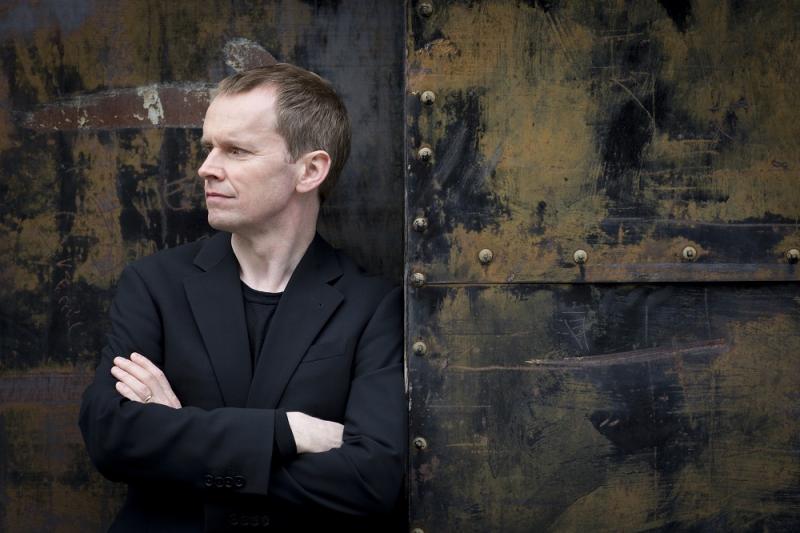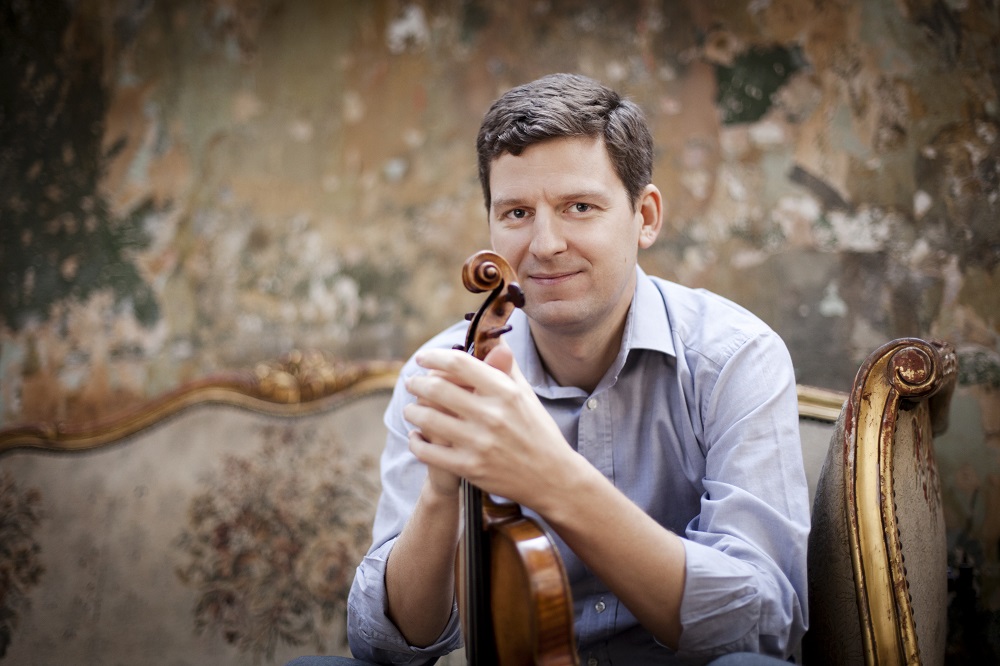Messiaen & Shostakovich, St John's Smith Square review - Osborne and Gerhardt anchor 1940s masterpieces | reviews, news & interviews
Messiaen & Shostakovich, St John's Smith Square review - Osborne and Gerhardt anchor 1940s masterpieces
Messiaen & Shostakovich, St John's Smith Square review - Osborne and Gerhardt anchor 1940s masterpieces
Lucidity, violence and transcendence in wartime meditations and combats

Only connect.
 In all three cases, horror and a possible transcendence could only be adequately conveyed through rigour. And it took the peerless sophistication of violinist James Ehnes (pictured left by Benjamin Ealovega), cellist Alban Gerhardt, pianist Steven Osborne and clarinettist Jean Johnson to keep the anguish of Shostakovich and the apocalyptic outbursts of Messiaen's prison visions in focus. If anything Ehnes is almost too cultured a musician for the savage humour of the scherzo in Shostakovich's Second Piano Trio or the way in which its finale's kletzmer-style themes are shredded in a terrifying conflagration. No soloist, though, could better inscape the meditative quality of the opening – the violin expressing pain in a lower register than the high-wire cello – or the Bach-like lament placed over the piano's inexorable Passacaglia chords in the Largo.
In all three cases, horror and a possible transcendence could only be adequately conveyed through rigour. And it took the peerless sophistication of violinist James Ehnes (pictured left by Benjamin Ealovega), cellist Alban Gerhardt, pianist Steven Osborne and clarinettist Jean Johnson to keep the anguish of Shostakovich and the apocalyptic outbursts of Messiaen's prison visions in focus. If anything Ehnes is almost too cultured a musician for the savage humour of the scherzo in Shostakovich's Second Piano Trio or the way in which its finale's kletzmer-style themes are shredded in a terrifying conflagration. No soloist, though, could better inscape the meditative quality of the opening – the violin expressing pain in a lower register than the high-wire cello – or the Bach-like lament placed over the piano's inexorable Passacaglia chords in the Largo.
Hair-raising violence was to be found in Osborne's superbly well-weighted outbursts at the heart of the finale. Here's a pianist who really does run the gamut, essential for the extremes of Messaien, a composer whose music no-one plumbs more amazingly. His Quartet for the End of Time started with deeper perspectives than in any other performance I've ever heard, the piano most remote, violin and cello in the middle distance, clarinet foregrounding, while the rainbow clusters of the seventh movement made the ears ring.
 Johnson (pictured right), a fine-tuned chamber musician, didn't quite reach the greatest solo clarinet playing in "Abime des oiseaux" – recent memories of Michael Collins and Julian Bliss on the edge of audibility were hard to shift – but the transcendent was absolutely sounded in Gerhardt's unshaken legato for "Praise to the Eternity of Jesus". Technical perfection is difficult if you're never going to break the line, and unnecessary if you lead as profound a meditation as this. And though Ehnes made you more conscious of instrumental tone in the "All is love" of the ineffable epilogue – you want, ideally, to forget the physical embodiment of the sound and focus entirely on the visionary message, as Gerhardt miraculously managed – then the final float heavenwards with Osborne managed the special magic of not letting the listener know where the sound, fading to nothing, actually stopped.
Johnson (pictured right), a fine-tuned chamber musician, didn't quite reach the greatest solo clarinet playing in "Abime des oiseaux" – recent memories of Michael Collins and Julian Bliss on the edge of audibility were hard to shift – but the transcendent was absolutely sounded in Gerhardt's unshaken legato for "Praise to the Eternity of Jesus". Technical perfection is difficult if you're never going to break the line, and unnecessary if you lead as profound a meditation as this. And though Ehnes made you more conscious of instrumental tone in the "All is love" of the ineffable epilogue – you want, ideally, to forget the physical embodiment of the sound and focus entirely on the visionary message, as Gerhardt miraculously managed – then the final float heavenwards with Osborne managed the special magic of not letting the listener know where the sound, fading to nothing, actually stopped.
- Read more classical reviews on theartsdesk
- David Nice's blog on Hubert Butler
- This year Alban Gerhardy founded Musicians 4 United Europe - website here
The future of Arts Journalism
You can stop theartsdesk.com closing!
We urgently need financing to survive. Our fundraising drive has thus far raised £49,000 but we need to reach £100,000 or we will be forced to close. Please contribute here: https://gofund.me/c3f6033d
And if you can forward this information to anyone who might assist, we’d be grateful.

Subscribe to theartsdesk.com
Thank you for continuing to read our work on theartsdesk.com. For unlimited access to every article in its entirety, including our archive of more than 15,000 pieces, we're asking for £5 per month or £40 per year. We feel it's a very good deal, and hope you do too.
To take a subscription now simply click here.
And if you're looking for that extra gift for a friend or family member, why not treat them to a theartsdesk.com gift subscription?
more Classical music
 Anja Mittermüller, Richard Fu, Wigmore Hall review - a glorious hall debut
The Austrian mezzo shines - at the age of 22
Anja Mittermüller, Richard Fu, Wigmore Hall review - a glorious hall debut
The Austrian mezzo shines - at the age of 22
 First Person: clarinettist Oliver Pashley on the new horizons of The Hermes Experiment's latest album
Compositions by members of this unusual quartet feature for the first time
First Person: clarinettist Oliver Pashley on the new horizons of The Hermes Experiment's latest album
Compositions by members of this unusual quartet feature for the first time
 Gesualdo Passione, Les Arts Florissants, Amala Dior Company, Barbican review - inspired collaboration excavates the music's humanity
At times it was like watching an anarchic religious procession
Gesualdo Passione, Les Arts Florissants, Amala Dior Company, Barbican review - inspired collaboration excavates the music's humanity
At times it was like watching an anarchic religious procession
 Classical CDs: Camels, concrete and cabaret
An influential American composer's 90th birthday box, plus British piano concertos and a father-and-son duo
Classical CDs: Camels, concrete and cabaret
An influential American composer's 90th birthday box, plus British piano concertos and a father-and-son duo
 Cockerham, Manchester Camerata, Sheen, Martin Harris Centre, Manchester review - re-enacting the dawn of modernism
Two UK premieres added to three miniatures from a seminal event of January 1914
Cockerham, Manchester Camerata, Sheen, Martin Harris Centre, Manchester review - re-enacting the dawn of modernism
Two UK premieres added to three miniatures from a seminal event of January 1914
 Kempf, Brno Philharmonic, Davies, Bridgewater Hall, Manchester review - European tradition meets American jazz
Bouncing Czechs enjoy their Gershwin and Brubeck alongside Janáček and Dvořák
Kempf, Brno Philharmonic, Davies, Bridgewater Hall, Manchester review - European tradition meets American jazz
Bouncing Czechs enjoy their Gershwin and Brubeck alongside Janáček and Dvořák
 Solomon, OAE, Butt, QEH review - daft Biblical whitewashing with great choruses
Even a top soprano and mezzo can’t make this Handel paean wholly convincing
Solomon, OAE, Butt, QEH review - daft Biblical whitewashing with great choruses
Even a top soprano and mezzo can’t make this Handel paean wholly convincing
 Two-Piano Gala, Kings Place review - shining constellations
London Piano Festival curators and illustrious friends entertain and enlighten
Two-Piano Gala, Kings Place review - shining constellations
London Piano Festival curators and illustrious friends entertain and enlighten
 Echo Vocal Ensemble, Latto, Union Chapel review - eclectic choral programme garlanded with dance
Beautiful singing at the heart of an imaginative and stylistically varied concert
Echo Vocal Ensemble, Latto, Union Chapel review - eclectic choral programme garlanded with dance
Beautiful singing at the heart of an imaginative and stylistically varied concert
 Scott, Irish Baroque Orchestra, Whelan, RIAM, Dublin review - towards a Mozart masterpiece
Characteristic joy and enlightenment from this team, but a valveless horn brings problems
Scott, Irish Baroque Orchestra, Whelan, RIAM, Dublin review - towards a Mozart masterpiece
Characteristic joy and enlightenment from this team, but a valveless horn brings problems
 Classical CDs: Voice flutes, flugelhorns and froth
Baroque sonatas, English orchestral music and an emotionally-charged vocal recital
Classical CDs: Voice flutes, flugelhorns and froth
Baroque sonatas, English orchestral music and an emotionally-charged vocal recital

Add comment